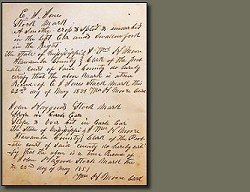 When I was a child, I would visit my aunt and uncle on their farm in the southwestern part of the county with my parents. My uncle, Samuel Feemster Riley came from an old Itawamba County pioneer family. His grandfather, John Thomas Riley was born during 1807 in Edgefield District, South Carolina and brought his family to Itawamba County during 1839 settling on English and Shoaf creeks in southwestern Itawamba County. Here the Riley family created a most productive cotton farm.
When I was a child, I would visit my aunt and uncle on their farm in the southwestern part of the county with my parents. My uncle, Samuel Feemster Riley came from an old Itawamba County pioneer family. His grandfather, John Thomas Riley was born during 1807 in Edgefield District, South Carolina and brought his family to Itawamba County during 1839 settling on English and Shoaf creeks in southwestern Itawamba County. Here the Riley family created a most productive cotton farm.The highlight of my visits with my uncle and aunt was the two-mile trip from their farm house to the old Riley homeplace. Situated well off the county road, we would drive down a shaded private country lane along the old Riley land in my uncle’s green 1947 Chevrolet pickup. The shaded lane opened up into a clearing where the old Riley homestead was situated, and where his two elderly bachelor brothers lived. The homestead consisted of the main house, a blacksmith shop, barns, a wash house, tenant house and other farm buildings. It was like a journey into the past visiting the old ancestral homestead.
The old main house was a treasure trove for a young boy. The big rooms with fourteen foot ceilings contained a plethora of old Itawamba County furnishings, many shipped up from Aberdeen on the Tombigbee river. I will always remember the large kitchen always displayed an 1897 wall calendar. I once asked my uncle why they didn’t change the calendar and he said “because that one has such a pretty picture.”
In the kitchen was a long oak dining table darkened with age where a bakers’ dozen could easily sit and upon the center of the table there was a little silver molasses pitcher. That shiny pitcher always fascinated me. My uncle once told me that his mother, Amelia Rankin Riley, purchased the pitcher around 1905 from a catalog and since it arrived, had always held its position on the old table. In Itawamba County, since pioneer days, sorghum molasses was a staple in every household. However most hill country molasses pitchers were manufactured of glass. But the one at the old Riley homestead was plated with silver which was most unusual.
During childhood, on every Christmas visit, my aunt and uncle would give me a special present of 100 pennies they had saved up, neatly tied up in white wrapping tissue paper with shiny red and green ribbons. But one special Christmas after receiving my 100 pennies, my elderly uncle went into the front parlor of the old farm house and returned with a little brown box and said “Merry Christmas.” Upon opening the box, I found that shiny silver molasses pitcher from the old pioneer home place. I was so excited to receive such a treasure from the old Riley homestead and even today, many years later, looking at that pitcher on my own table always brings back childhood memories of magical visits to the old 1839 Riley farm.
About the Molasses Pitcher
The silver-plated pitcher is numbered and stamped with the wording “Homan Mfg. Company” and “Special Metal.” The Homan Manufacturing Company was organized during 1847 in Cincinnati, Ohio by Henry Homan and Asa F. Flagg. They began work in pewter wares. After Henry Homan died, his widow and sons operated the firm until 1887 and it was during this era that they changed over much of their production to electroplating with silver and became known for ecclesiastical designs including chalices, beakers and tankards and had several commissions from Ohio and Mississippi river boats for equipment including swivel lamps and water pitchers. During 1896 the company went under the name of Homan Silver Plate Co. and between 1904 and 1915 became known as the Homan Mfg. Co. The company ceased business by 1941.
Photograph of Riley farm taken during the 1930's





3 comments:
Interesting I believe I am in possession of one of those water pitchers from the Homan Manufacturing Company can you provide information on it's value, appraisals or buyers.
paul c.
Iam trying to get info on a Silver Double wall Water Pitcher. It has a patent date of Oct 29 1878. Made by the Homan Silver Plate Co. it also says that its quadruple plate. Thank you for any information you an give me.
I am interested in learning more, I have just come into possession of a mirror stand with 4 cups and beveled mirror which is marked Homan Mfg and numbered. It also states it is quadruple plate. Any ideas on where to search for more info?
Post a Comment